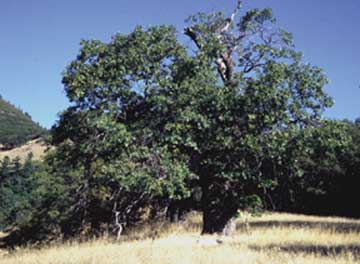- California Black Oak
Taxobox
name = California Black Oak

image_width = 240px
regnum =Plant ae
divisio = Magnoliophyta
classis =Magnoliopsida
ordo =Fagales
familia =Fagaceae
genus = "Quercus"
sectio = "Lobatae"
species = "Q. kelloggii"
binomial = "Quercus kelloggii"
binomial_authority = Newb.California Black Oak ("Quercus kelloggii"), also known as simply Black Oak, or Kellogg Oak, is an
oak in the red oak section ("Quercus" sect. "Lobatae"), native to westernNorth America . It is a close relative of theBlack Oak ("Quercus velutina") found in eastern and centralNorth America .California Black Oak is a
deciduous tree , typically growing from 9-25 m (30-80 ft) in height and from 0.3-1.4 m (1-4.5 ft) in diameter. Large trees may exceed 36 m (120 ft) in height and 1.6 m (5 ft) diameter. The species also grows in scrub form on poor sites. In open areas the crown is broad and rounded, with lower branches nearly touching the ground or forming a browse line. In closed stands, the crown is narrow and slender in young trees and irregularly broad in old trees. Trunks are usually free of branches for 6-12 m (20-40 ft) in closed stands. Trunks are often forked, and usually decayed and hollow in older trees. The bark is thin and smooth in young trees, becoming moderately thick, deeply fissured, and platy with age. This oak grows from one to several vertical roots which penetrate to bedrock, with large, laterally spreading roots extending off from vertical ones. It also has a number of surface roots. Acorns are relatively large in this species, from 2.5-3 cm (1-1.2 in) long and 1.5-1.8 cm (0.6-0.7 in) wide. The deeply lobed leaves are typically 10-20 cm (4-8 in) long. California black oak can live up to 500 years of age.California Black Oak is distributed along foothills and lower mountains of
California and southernOregon . It is found fromLane County, Oregon south through theCascade Range , the Sierra Nevada, and the Coast, Transverse, and Peninsular ranges toSan Diego County, California . The tree occurs in pure or mixed stands. Pure stands usually indicate sites unfavorable to conifer growth or recurring disturbance such as fire or logging activities.It is a critical species for wildlife. Oaks ("Quercus" spp.) may be the single most important genus used by wildlife for food and cover in California forests and rangelands, and California Black Oak occupies more total area in California than any other hardwood species. Livestock also make heavy use of this species for food and cover.
Cavities in the trees provide den or nest sites for
owl s, variouswoodpecker s,tree squirrel s, andAmerican Black Bear s. Trees provide valuable shade for livestock and wildlife during the hot summer months. California Black Oak forest types are heavily used for spring, summer, and fall cover by Black Bear.It is browsed by
Mule Deer and livestock. Acorns are heavily utilized by livestock, Mule Deer, feralpig s, rodents,Mountain Quail ,Steller's Jay , andwoodpecker s. Acorns constitute an average of 50% of the fall and winter diets ofWestern Gray Squirrel andBlack-tailed Deer during good mast years. Fawn survival rates increase or decrease with the size of the acorn crop.It is a preferred foraging substrate for many birds. All of 68 bird species observed in oak woodlands of the
Tehachapi Mountains of California used California black oak for part of their foraging activities.Acorn Woodpecker ,Bullock's Oriole , andNashville Warbler show strong preference for California Black Oak.Cultivation & uses
California Native Americans preferred California Black Oak acorns over those of other species for making acorn meal. The
wood is used for making cabinets, furniture, high grade lumber, pallets, and industrial timbers. It is also used as fuelwood.California Black Oak comprises a total volume of 29% of California's hardwood timber resources, and is the major hardwood sawn into lumber there. The total estimated area of species occurrence is 361,800 ha (3,618 km² or 894,000 acres); 239,200 ha (2,392 km² or 591,000 acres) of timberland and 122,600 ha (1,226 km² or 303,000 acres) of woodland. Of this land 60% is privately owned, 31% is in National Forests, and 9% is on other public lands. It has greatly decreased from its historic abundance. This is due to a number of factors, including drought, disease, animal foraging, logging practices, fire suppression, and a variety of other human impacts. Cutting green trees for fuelwood has contributed to the decline of this species, and illegal harvesting of green trees from public lands is a continuing problem.
It was long considered by foresters and government agencies as a weed tree. In its earlier years, its only use was to feed the boilers of donkey engines bringing in the valuable pine and fir logs. There was a period in the mid 1960's when U.S. Forest Service policy in California's National Forests for the California black oak was systematic extermination by girdling the trees. The objective was to make room for more coniferous growth. In the rush to utilize the magnificent pines, firs and redwoods, the dense hardwoods were looked on with contempt. Like a few other visionaries in the 1960s,
Guy Hall thought the California Black Oak presented a beautiful challenge that deserved better than eradication. In 1965 Hall convinced federal agencies to cease their extermination polices.Plantation s of California Black Oak have been successfully established in clearcuts from acorn plantings. Thinning such stands promotes stand productivity and wood quality, and is recommended when trees are from 9-15 m (30-50 ft) tall or when stand density (basal area) exceeds 29 m²/ha (125 ft²/acre). This tree has also been managed for hardwood production by maintaining scattered pure stands within coniferous forests. Stands of this species will often establish on poorer sites, where conifer seedling establishment has not been successful.References
* [http://www.efloras.org/florataxon.aspx?flora_id=1&taxon_id=233501052 Flora of North America: "Quercus kelloggii"]
*Hall, G. (1998). "The management, manufacture, marketing of California black oak, Pacific madrone and tanoak: A practical handbook on successful hardwood utilization in California and southern Oregon". Western Hardwood Association.
Wikimedia Foundation. 2010.
